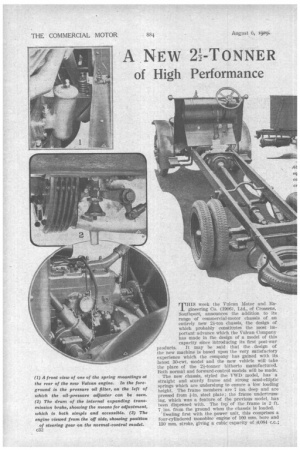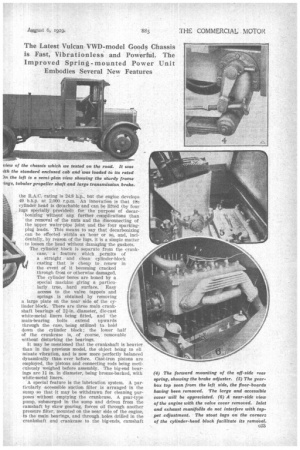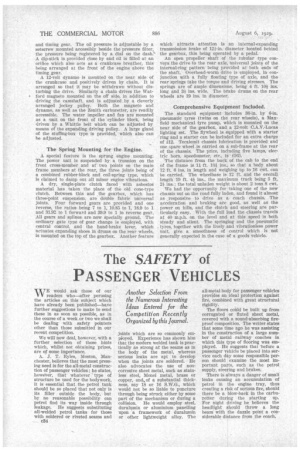A NEW 2-TONNER
Page 54

Page 55

Page 56

If you've noticed an error in this article please click here to report it so we can fix it.
of High Performance
rilHIS week the Vulcan Motor and En gineering Co. (1906), Ltd., of Crossens, Southport, announces the addition to its range of commercial-motor chassis of an entirely new 2i-ton chassis, the design of which probably constitutes the most Important advance which, the Vulcan Company has made in the design of a model of this capacity since introducing its first post-war products. It may be said that the • design of the new machine is based upon the very satisfactory experience which the company has gained with its latest 30-cwt. -model and the new vehicle will take the place of the 21-tonner hitherto manufactured. Both normal and forward-control models will be made.
The new chassis, styled the VWD model, has a straight and sturdy frame and strong semi-elliptic springs which are underslung to ensure a low loading height. The frame members are 7 ins, deep and are ryt.ssed from Fin, steel plate; the frame undertrussMg, which was a feature of the previous model, has been dispensed with. The fopof the frame is 2 ft. 7 ins, from the ground when the chassis is loaded.
'Dealing first with the power unit, this comprises a four-cylindered monobloc engine of 100 inna: bore and 130 mm. stroke, giving a cubic capacity of :4,084 c.c.; the R.A.C. rating is 24S h.p., but the engine develops b.h.p. at 2,000 r.p.m. An innovation is that tie cylinder head is detachable and can be lifted (by four
lugs Specially provided) for the purpoSe. of decar
bonizing without any further complications than the removal of the nuts and the disconnecting of the upper water-Pipe Joint and the four sparking plug leads. This means to say that decarbonizing can be effected Within an 'hour or so, and, inci dentally, by reason of the lugs, it is a simple matter • to loosen the head Without damaging the gaskets. The cylinder block is separate from the crankcase, a feature whieh permits of a straight and clean cylinder-block . casting that is cheap to renew in the event of it becoming cracked through frost or otherwise damaged. The cylinder bores are honed by a special machine giving a particularly true, hard surface. Easy access to the valve tappets and springs is obtained by removing a large plate on the near side of the cy linder block. There are three main crank shaft bearings of 2-R-in, diameter, die-cast white-metal liners being fitted, and the main-bearing bolts extend upwards through the ease, being utilized to hold down the cylinder block; the lower half of the crankcase is, of course, removable without disturbing the bearings.
It may he mentioned that the crankshaft is heavier than in the previous model, the object being to eli initiate vibration, and is now more perfectly balanced dynamically than ever before. Cast-iron pistons are employed, the pistons and connecting rods being meticulously weighed before assembly. The big-end bearings are 11 in. in diameter, being bronze-backed, with white-metal liners. •
'A special feature is the lubrication system. A particularly accessible suction filter is arranged in the sump -so that it may be withdrawn for cleaning purposes without emptying the crankcase. A gear-type pump, submergedin the sump and driven from the camshaft by skew gearing, forces oil through another pressure filter, mounted on the near side of the engine, to the main bearings, and through holes drilled in the crankshaft and crankcase to the big-ends, camshaft and timing gear. The oil pressure is adjustable by a setscrew mounted accessibly beside the pressure filter, the pressure being registered by a dial on the dash."' A dip-stick is provided close by and oil is filled at an orifice which also acts as a crankcase breather, this being arranged at the front of the engine above the timing gear.
A 12-volt dynamo is mounted on the near side of the crankcase and positively driven by chain. It is arranged so that it may be withdrawn without disturbing the drive. Similarly a chain drives the Wat • ford magneto mounted on the off side, in addition to driving the camshaft, and is adjusted by a cleverly arranged jockey pulley. Both the magneto and dynamo, as well as the Zenith carburetter, are readily accessible. The water impeller and fan are mounted as a unit on the front of the cylinder block, being driven by a Whittle belt which can be adjusted by means of the expanding driving pulley. A large gland of the stuffing-box type is provided, which also can he adjusted.
The Spring Mounting for the Engine.
A special feature is the sprung engine mounting. The power unit is suspended by a trunnion on the front cross-member and at two points on the main frame members at the rear, the three joints being of a combined rubber-block and coil-spring type, which is claimed to damp out all minor engine vibrations.
A dry, single-plate clutch faced with asbestos material has taken the place of the old cone-type clutch. Between this and the gearbox, which has three-,point suspension, are double fabric universal joints. Four forward gears are provided and one reverse, the ratios being 7 to 1, 10.85 to 1, 18.9 to 1 and 31.92 to 1 forward and 39.9 to 1 in reverse gear. All gears and splines are now specially ground. The ordinary gate type of gear change is employed, with central control, and the hand-brake lever, whieli actuates expanding shoes in drums on the rear wheels, is mounted on the top of the gearbox. Another feature
which attracts attention is an internal-expanding transmission brake of 121-in. diameter located behind the gearbox, this being operated by a pedal.
An open propeller shaft of the tubular type conveys the drive to the rear axle, universal joints of the internal-ring pattern being provided at both ends of the shaft. Overheadavorm drive is employed, in conjunction with a fully floating type of axle, and the rear springs take the torque and driving stresses. The springs are of ample dimensions, being 4 ft. 101 ins. long and 31 ins. wide. The brake drums on the rear wheels are 19 ins, in diameter.
Comprehensive Equipment Included.
The standard equipment includes 36-in. by 6-in. pneumatic tyres (twins on the rear wheels), a Maxfield mechanical tyre pump, which is mounted on the near side of the gearbox, and a 12-volt C.A.V.-Lneas lighting set. The flywheel is equipped with a starter ring and a starter can be included for an extra charge of £12. Tecalemit chassis lubrication is provided and one snare wheel is carried on a sub-frame at the rear of the chassis. The price, including five lamps, elec. tric horn, speedometer, etc., is £565. The distance from the back of the cab to the end of the frame is 11 ft. 101 ins., so that a body about 12 ft. 6 ins, in length and weighing up to 16 cwt. can he carried. The wheelbase is 12 ft. and the overall length 19 ft. 41 ius., the maximum track being 5 ft. 21 ins. ; the total unladen weight is about 2 tons 8 cwt.
We had the opportunity for taking one of the new chassis out on the road fully laden, and found it almost as responsive to drive as a coach chassis. The acceleration and braking are good, as well as the power on hills, and the clutch and steering are particularly easy. With the full load the chassis travels at 40 m.p.h. on the level and at this speed is both steady and silent. The springing and the pneumatic tyres, together with the lively and vibrationless power unit, give a smoothness of control which is not generally expected in the case of a goods vehicle.














































































































